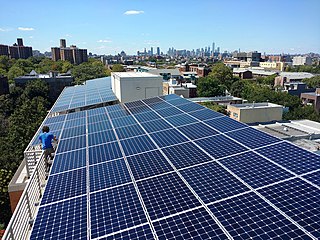Related Research Articles

Net metering is an electricity billing mechanism that allows consumers who generate some or all of their own electricity to use that electricity anytime, instead of when it is generated. This is particularly important with renewable energy sources like wind and solar, which are non-dispatchable. Monthly net metering allows consumers to use solar power generated during the day at night, or wind from a windy day later in the month. Annual net metering rolls over a net kilowatt-hour (kWh) credit to the following month, allowing solar power that was generated in July to be used in December, or wind power from March in August.
The Renewables Obligation (RO) is designed to encourage generation of electricity from eligible renewable sources in the United Kingdom. It was introduced in England and Wales and in a different form in Scotland in April 2002 and in Northern Ireland in April 2005, replacing the Non-Fossil Fuel Obligation which operated from 1990.

Microgeneration is the small-scale production of heat or electric power from a "low carbon source," as an alternative or supplement to traditional centralized grid-connected power.
Financial incentives for photovoltaics are incentives offered to electricity consumers to install and operate solar-electric generating systems, also known as photovoltaics (PV).
A feed-in tariff is a policy mechanism designed to accelerate investment in renewable energy technologies by offering long-term contracts to renewable energy producers. This means promising renewable energy producers an above-market price and providing price certainty and long-term contracts that help finance renewable energy investments. Typically, FITs award different prices to different sources of renewable energy in order to encourage development of one technology over another. For example, technologies such as wind power and solar PV are awarded a higher price per kWh than tidal power. FITs often include a "degression": a gradual decrease of the price or tariff in order to follow and encourage technological cost reductions.
Feed-in electricity tariffs (FiT) were introduced in Germany to encourage the use of new energy technologies such as wind power, biomass, hydropower, geothermal power and solar photovoltaics. Feed-in tariffs are a policy mechanism designed to accelerate investment in renewable energy technologies by providing them remuneration above the retail or wholesale rates of electricity. The mechanism provides long-term security to renewable energy producers, typically based on the cost of generation of each technology. Technologies such as wind power, for instance, are awarded a lower per-kWh price, while technologies such as solar PV and tidal power are offered a higher price, reflecting higher costs.

Solar power includes solar farms as well as local distributed generation, mostly on rooftops and increasingly from community solar arrays. In 2021, utility-scale solar power generated 115 terawatt-hours (TWh), or 2.8% of electricity in the United States. Total solar generation that year, including estimated small-scale photovoltaic generation, was 164 TWh.
Energy subsidies are measures that keep prices for customers below market levels, or for suppliers above market levels, or reduce costs for customers and suppliers. Energy subsidies may be direct cash transfers to suppliers, customers, or related bodies, as well as indirect support mechanisms, such as tax exemptions and rebates, price controls, trade restrictions, and limits on market access.

Feed-in tariffs in Australia are the feed-in tariffs (FITs) paid under various State schemes to non-commercial producers of electricity generated by solar photovoltaic (PV) systems using solar panels. They are a way of subsidising and encouraging uptake of renewable energy and in Australia have been enacted at the State level, in conjunction with a federal mandatory renewable energy target.
The Green Energy Act (GEA), formally the Green Energy and Green Economy Act, 2009, introduced in the Ontario legislature on February 23, 2009 and later repealed on January 1, 2019, was intended to expand renewable energy production, encourage energy conservation and create green jobs. Among many clauses, the GEA was best known for creating a number of feed-in tariff rates for different types of energy sources. Notable among these is the microFIT program for small non-commercial systems under 10 kilowatts, and FIT, the larger commercial version which covers a number of project types with sizes into the megawatts.

The Renewable Energy Sources Act or EEG is a series of German laws that originally provided a feed-in tariff (FIT) scheme to encourage the generation of renewable electricity. The EEG 2014 specified the transition to an auction system for most technologies which has been finished with the current version EEG 2017.

Solar power has been growing in the U.S. state of Oregon in recent years due to new technological improvements and a variety of regulatory actions and financial incentives enacted by the state government.
PACE financing is a means used in the United States of America of financing energy efficiency upgrades, disaster resiliency improvements, water conservation measures, or renewable energy installations in existing or new construction of residential, commercial, and industrial property owners. Depending on state legislation, PACE financing can be used to finance water efficiency products, seismic retrofits, resiliency, and other measures with social benefits.
The Renewable Heat Incentive is a payment system in England, Scotland and Wales, for the generation of heat from renewable energy sources. Introduced on 28 November 2011, the RHI replaces the Low Carbon Building Programme, which closed in 2010.
A feed-in tariff is when payments are given by energy suppliers if a property or organisation generates their own electricity using technology such as solar panels or wind turbines and feeds any surplus back to the grid. In the United Kingdom, they were entered into law by the Energy Act 2008 and took effect from April 2010. The scheme closed to new applicants on 31 March 2019.
The Finland National Renewable Energy Action Plan is the National Renewable Energy Action Plan (NREAP) for Finland. The plan was commissioned by the Directive 2009/28/EC which required Member States of the European Union to notify the European Commission with a road map. The report describes how Finland planned to achieve its legally binding target of a 38% share of energy from renewable sources in gross final consumption of energy by 2020.
The United Kingdom is committed to legally binding greenhouse gas emissions reduction targets of 34% by 2020 and 80% by 2050, compared to 1990 levels, as set out in the Climate Change Act 2008. Decarbonisation of electricity generation will form a major part of this reduction and is essential before other sectors of the economy can be successfully decarbonised.

The Ontario Sustainable Energy Association (OSEA) is a non-profit organization supporting the growth of renewable energy and Community Power projects in the Canadian Province of Ontario. OSEA advocated an advanced renewable energy Feed-in Tariff program for Ontario, resulting in the creation of the Renewable Energy Standard Offer Program, a precursor to the Green Energy Act and, in 2007, the most progressive energy policy in North America in a decade. OSEA has approximately 130 community and industry members as well as individual members. The affairs of the association are managed by a board of directors elected by the membership.

Apollo's Fire: Igniting America's Clean Energy Economy is a 2007 book by Washington State Governor Jay Inslee and researcher Bracken Hendricks. Inslee first proposed an Apollo-scale program, designed to galvanize the nation around the urgent goal of solving the environmental and energy crisis, in the Seattle Post-Intelligencer in 2002. Eventually Inslee co-authored Apollo's Fire, in which he says that through improved Federal policies the United States can wean itself off of its dependence on foreign oil and fossil fuel, create millions of green-collar worker jobs, and stop global warming. Along these lines, he has been a prominent supporter of the Apollo Alliance.

Green industrial policy (GIP) is strategic government policy that attempts to accelerate the development and growth of green industries to transition towards a low-carbon economy. Green industrial policy is necessary because green industries such as renewable energy and low-carbon public transportation infrastructure face high costs and many risks in terms of the market economy. Therefore, they need support from the public sector in the form of industrial policy until they become commercially viable. Natural scientists warn that immediate action must occur to lower greenhouse gas emissions and mitigate the effects of climate change. Social scientists argue that the mitigation of climate change requires state intervention and governance reform. Thus, governments use GIP to address the economic, political, and environmental issues of climate change. GIP is conducive to sustainable economic, institutional, and technological transformation. It goes beyond the free market economic structure to address market failures and commitment problems that hinder sustainable investment. Effective GIP builds political support for carbon regulation, which is necessary to transition towards a low-carbon economy. Several governments use different types of GIP that lead to various outcomes.
